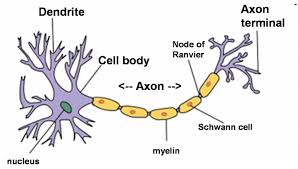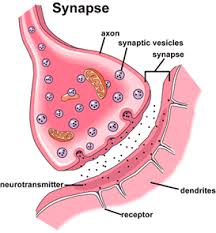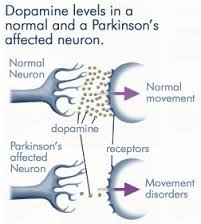Lesson 1: Predisposition, Biological Factors, and the Brain
Brain Dysfunction
Effective brain functioning relies on the way nerve cells (neurons) transmit their messages across synapses (junction points) to the next neurons. Neurons are specialized in their shape and position. The neurons do not touch each other. Small gaps, called synapses, lie between neurons. To get a message across a synapse, neurons release chemicals called neurotransmitters. An electrical impulse travels along a neuron, but when it reaches the end of the neuron, instead of the electrical impulse travelling into the next cell, neurotransmitters are released. These neurotransmitters then travel into the synapse between the two neurons, seeking a specialized receptor where they can fit onto the next neuron. We have many types of neurotransmitters, and they are all shaped differently. To have an effect on another neuron, the neurotransmitter must fit into a site specifically designed for them. To visualize this process, think of the way that your house key can open only the door to your own house.
Different neurotransmitters have different effects in the body, but all neurotransmitters must be working properly for a person to be able to sleep, move, and even maintain a positive outlook on life. The following are some of the neurotransmitters found in the human body.
Acetycholine - functions in the parasympathetic division of the nervous system and helps to return increased heart rate to normal.
Dopamine - found in areas of the brain that manage movement, emotional arousal, learning, and memory.
Epinephrine - (both a hormone and neurotransmitter) increases heart rate and blood pressure
Serotonin - produced in the central nervous system and has a role in sleep and emotional arousal. Lack of serotonin production or availability in the synapses is thought to be responsible for severe depression in some individuals. People suffering from depression find difficulty experiencing any uplifting emotions or happiness. They may also have a very difficult time sleeping. Antidepressants, drugs that are chemically designed to keep serotonin in the synapse long enough to attach to another neuron and have its proper effect, have been used with great success in alleviating severe depression.
| Neuron | Synapse with Neurotransmitters |
 |
 |
Examples of disorders relating to brain dysfunction include Alzheimer’s, Parkinson’s, epilepsy, and Creutzfeldt-Jakob disease. The Internet provides the most current information on Creutzfeldt-Jakob disease.
Epilepsy
Epilepsy is a neurological disorder that occurs when abnormal electrical impulses occur in the brain. The impulses may involve the body seizing or convulsing. Seizures may occur randomly, and most are accompanied by a loss of consciousness. Some people may experience seizures many times per day while others may have years go by between seizures. Doctors believe that some epileptic seizures are caused by high fevers or infection, but other seizures seem to occur randomly with no specific detectable causes. Epilepsy is thought to have genetic links because it is more likely to appear in families. Treatment may involve medication that prevents convulsions. In severe circumstances, brain surgery may be an option. If the aberrant impulses are specific to certain areas of the brain, the brain surgery may involve cutting certain neural connections, thereby preventing the abnormal electrical impulses from affecting areas they should not.
Parkinson’s Disease
Parkinson’s disease occurs when a specific part of the brain starts to degenerate. This section, called the  Substantia Nigra, contains cells that release the neurotransmitter dopamine that is thought to have some role in controlling movement. The symptoms of Parkinson’s disease include shaking, muscle rigidity while at rest, involuntary movements, inability to maintain a body position, difficulty moving, and problems producing speech.
Substantia Nigra, contains cells that release the neurotransmitter dopamine that is thought to have some role in controlling movement. The symptoms of Parkinson’s disease include shaking, muscle rigidity while at rest, involuntary movements, inability to maintain a body position, difficulty moving, and problems producing speech.
The main challenge researchers face in developing a cure for Parkinson’s is finding some way to stop the degeneration of the Substantia Nigra. Until a cure for the degeneration can be discovered, doctors must treat this disease with medication that enables the body to keep dopamine in its system.
Physical Deprivation
 People require food, air, water, sleep, and other fundamental components to survive. These are the basic needs of all humanity. If such essential components are interfered with for a prolonged period of time, the ability to deal with stress drops dramatically. Prisoners have sometimes been “broken” by nothing more persuasive than the systematic prevention of sleep or deprivation of food over several days (Carson, Butcher, Coleman, 1988). Experimental studies where volunteers deprived themselves of sleep for over three days (up to 98 hours) showed that the subjects became disoriented, irritable, anxious, paranoid, and unable to concentrate. Another study on semi-starvation (Keys, 1950) is illustrated.
People require food, air, water, sleep, and other fundamental components to survive. These are the basic needs of all humanity. If such essential components are interfered with for a prolonged period of time, the ability to deal with stress drops dramatically. Prisoners have sometimes been “broken” by nothing more persuasive than the systematic prevention of sleep or deprivation of food over several days (Carson, Butcher, Coleman, 1988). Experimental studies where volunteers deprived themselves of sleep for over three days (up to 98 hours) showed that the subjects became disoriented, irritable, anxious, paranoid, and unable to concentrate. Another study on semi-starvation (Keys, 1950) is illustrated.
|
Thirty-two conscientious objectors served as volunteer subjects. The men were first placed on an adequate diet for three months, then placed on a very low calorie diet characteristic of European famine areas for a period of six months, and then provided with a three-month period of nutritional rehabilitation. During the six-month period of semi-starvation, subjects had an average weight loss of 24 percent. At the same time, subjects also showed dramatic personality and behavioral changes. They became irritable, unsociable, and increasingly unable to concentrate on anything but food. In some instances they resorted to stealing food from one another and lying in attempts to obtain additional food rations. Among other psychological changes were apathy, loss of pride in personal appearance, and feelings of inadequacy. By the close of the experiment, there was a marked reduction or disappearance of their interest in sex, and the predominant mood was one of gloom and depression. Food dominated the men’s thoughts, conversations, and even daydreams. They even pinned up pictures of chocolate cake instead of pretty women. In some cases, they went so far as to re-plan their lives in the light of their newly acquired respect for food. The investigators concluded that by the end of the twenty-fifth week, hunger had become the dominant influence in the behavior of their subjects. |
Besides the example of hunger, one can also think of trying to carry out a normal workload or schedule when very ill with a flu. Both our ability to cope and our behaviour are negatively affected.
The second component of physical deprivation is stimulation – or rather, the lack thereof. The importance of stimulation received by an infant is crucial to healthy development. Since the 1940s, researchers have known that a child who receives inadequate stimulation is at risk for emotional difficulties. In fact, some institutionalized infants (orphans) who did not receive attention and human contact, wasted away and died. The consequence of infant death due to lack of stimulation was termed hospitalization syndrome. A study, performed by Harry Harlow in 1966, involved rhesus monkeys. This study showed the importance of love and attention in the development of offspring. The experiment was, unfortunately, cruel and unethical; for humane reasons it would not be performed by scientists in North America today.